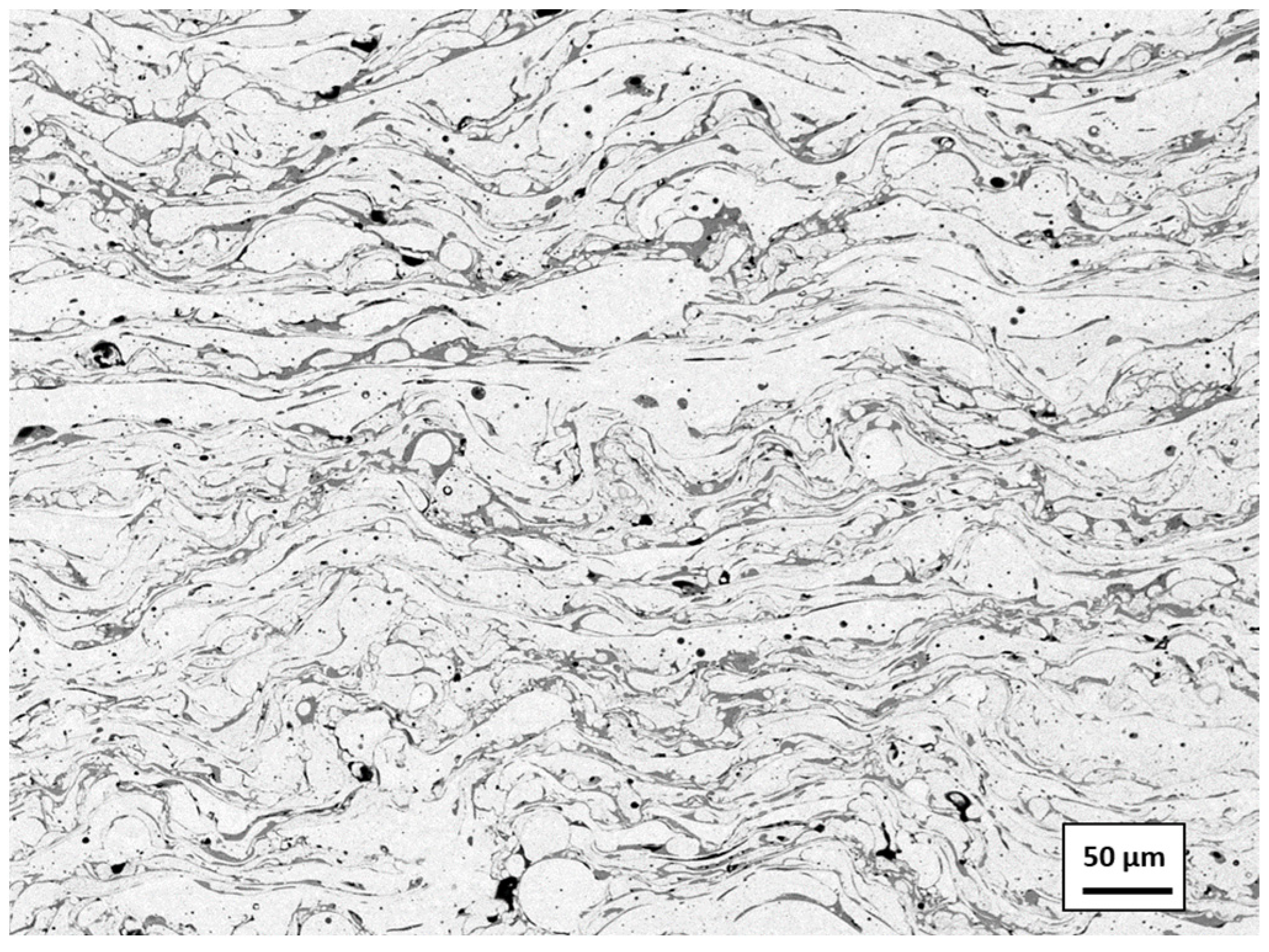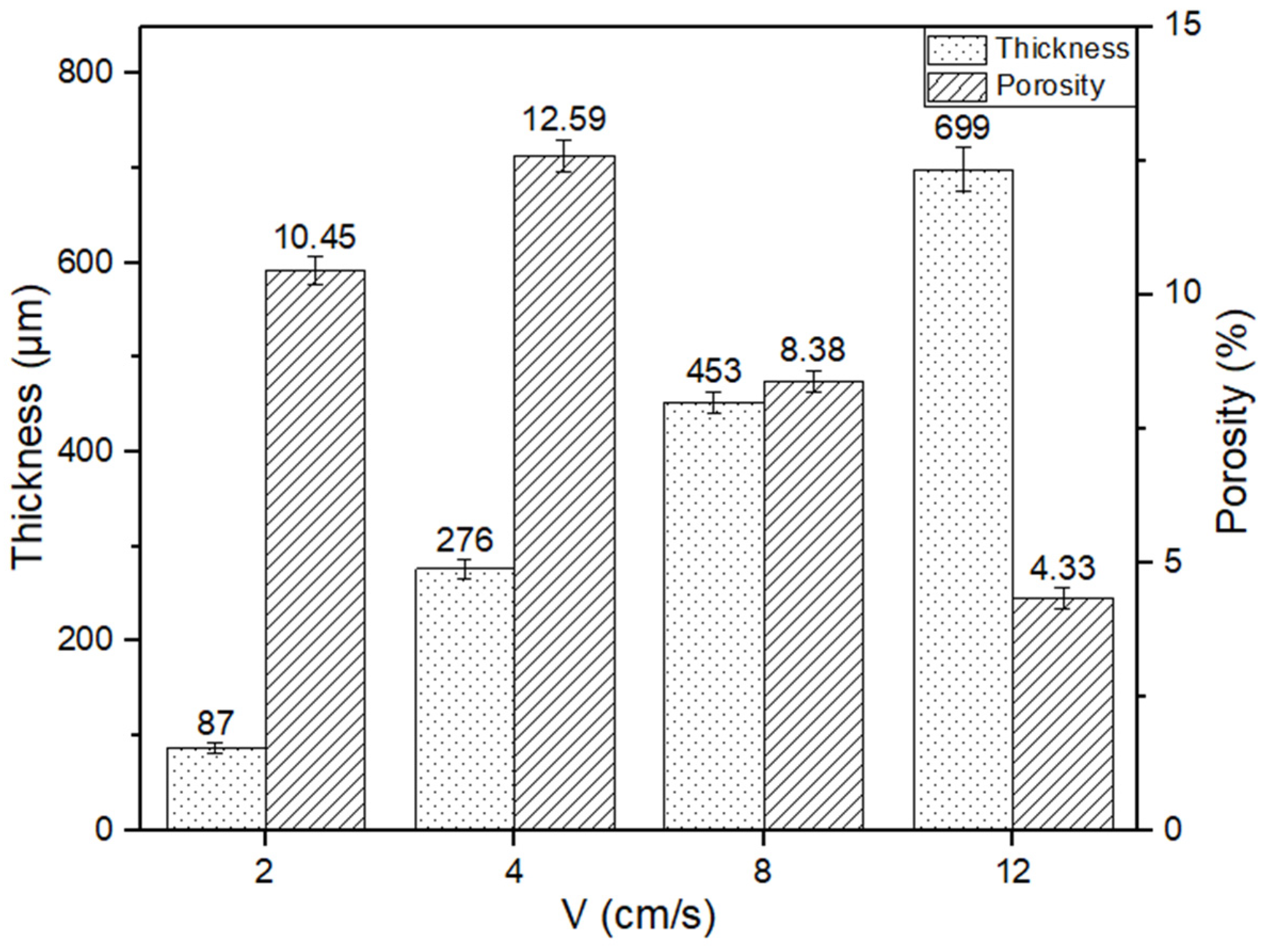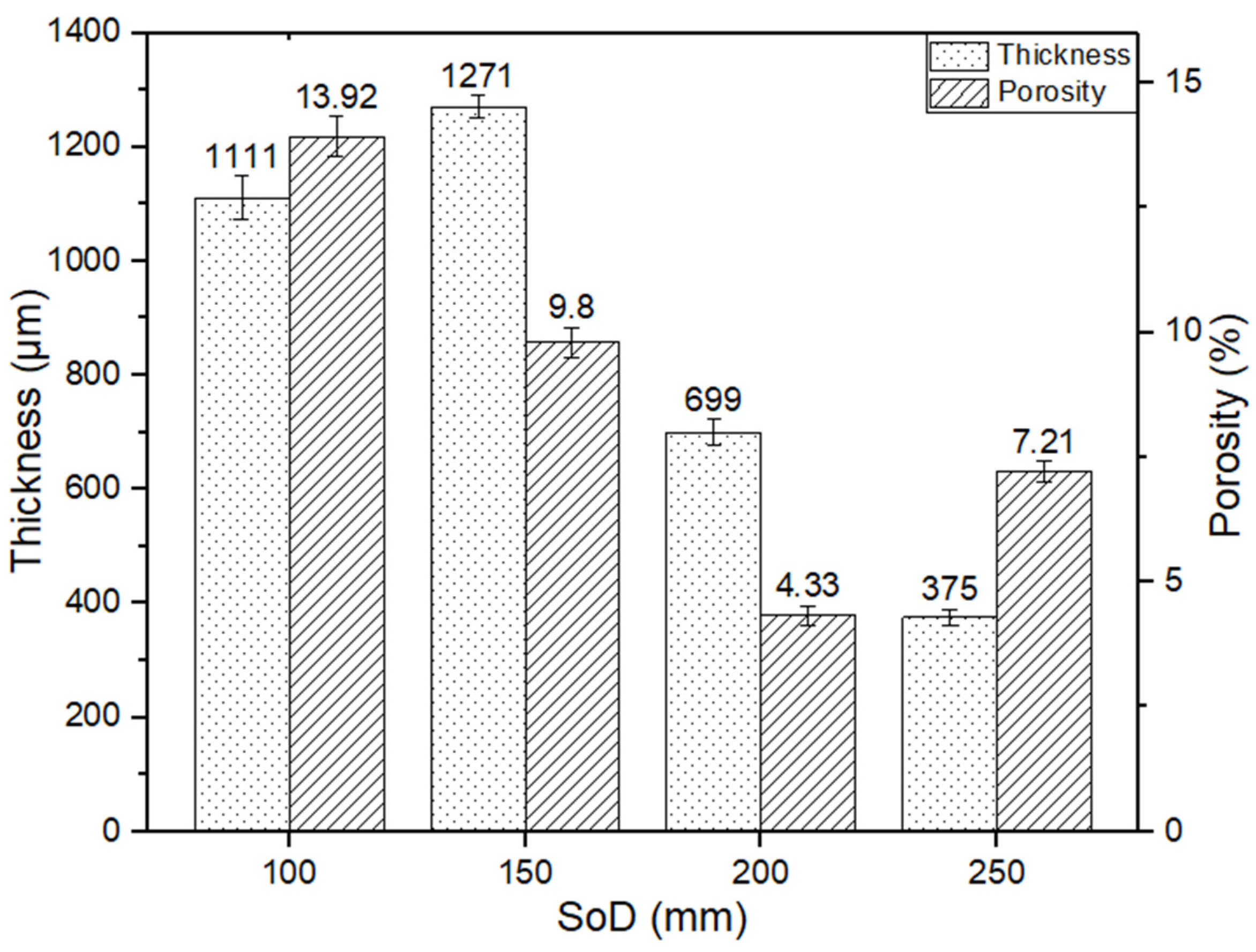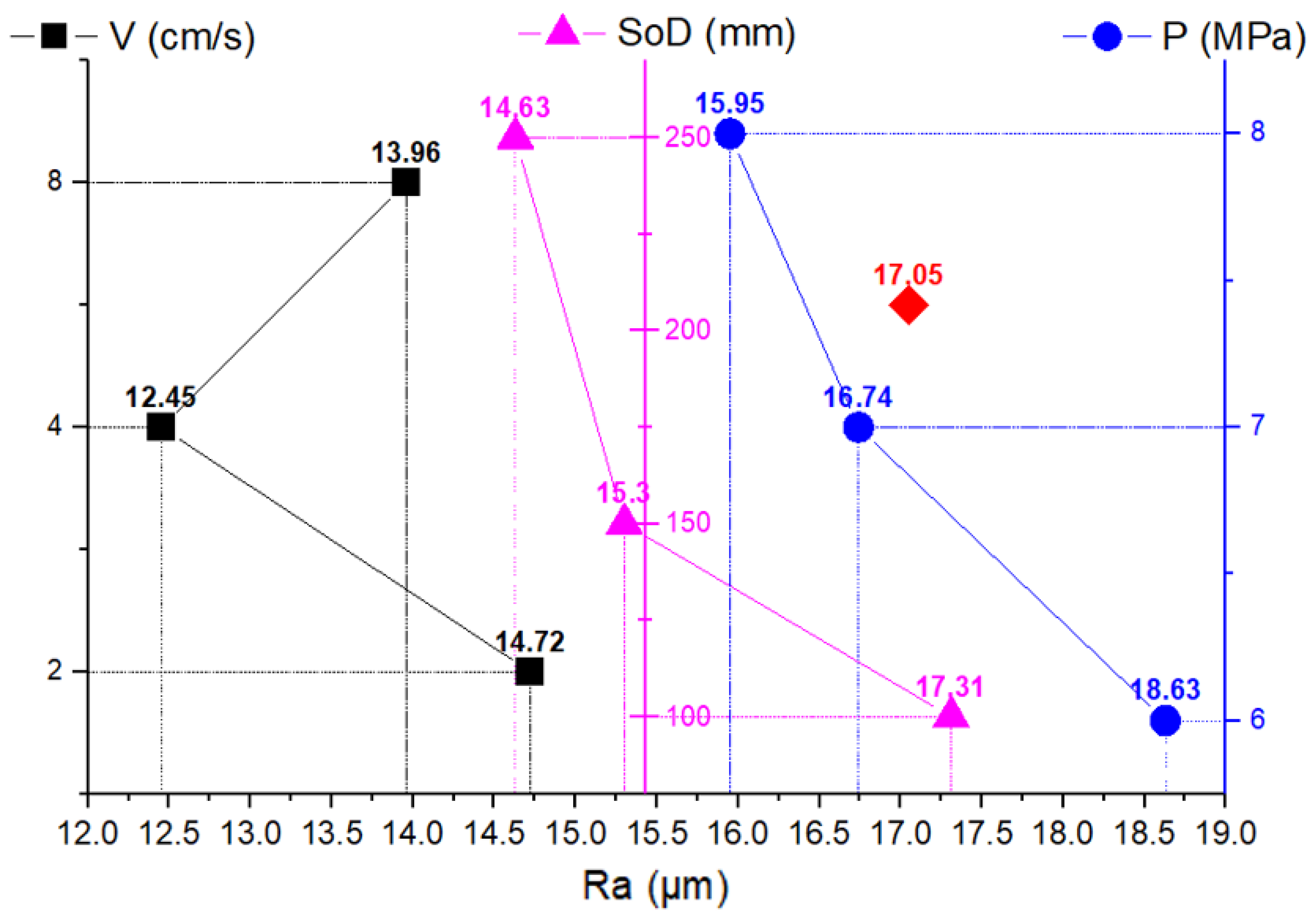Influence of Spraying Process Parameters on the Characteristics of Steel Coatings Produced by Arc Spraying Method
Abstract
:1. Introduction
2. Materials and Methods
2.1. Description of the Equipment Used
2.2. Characteristics of Materials Used and Sample Preparation
2.3. Methods for Evaluating the Characteristics of Coatings
3. Results
3.1. Microstructure
3.2. Thickness and Porosity
3.3. Surface Roughness and Adhesion
3.4. Vickers Hardness
4. Conclusions
- Increasing the wire feed rate from 2 to 12 cm/s leads to an increase in coating thickness to 699 μm and a significant reduction in porosity to 4.33%. However, further increasing the speed to 12 cm/s can increase the surface roughness. The hardness of the coating increases as the wire feed rate is raised from 2 to 8 cm/s, reaching 404 HV. However, a further increase to 12 cm/s results in a decrease in hardness.
- The optimal SoD for achieving a thicker coating is 150 mm, while a denser coating is achieved at 200 mm. However, increasing the SoD to 250 mm results in a significant decrease in coating thickness and an increase in porosity. The lowest hardness of the coating, 280 HV, is observed at an SoD of 100 mm, highlighting the importance of accurately selecting the SoD to achieve the best mechanical properties.
- The maximum thickness and minimum porosity values of the coatings are achieved at gas pressures of 7 and 9 MPa, indicating that these pressures are optimal for producing dense coatings. Gas pressure has a significant effect on the surface roughness, reducing it from Ra = 18.63 μm at 6 MPa to Ra = 15.95 μm at 8 MPa. The maximum hardness of the coating is achieved at a pressure of 7 MPa, emphasizing the need for precise pressure control to obtain the best mechanical properties.
Author Contributions
Funding
Institutional Review Board Statement
Informed Consent Statement
Data Availability Statement
Conflicts of Interest
References
- Ramezani, M.; Mohd Ripin, Z.; Pasang, T.; Jiang, C.-P. Surface Engineering of Metals: Techniques, Characterizations and Applications. Metals 2023, 13, 1299. [Google Scholar] [CrossRef]
- Rakhadilov, B.; Maulet, M.; Abilev, M.; Sagdoldina, Z.; Kozhanova, R. Structure and Tribological Properties of Ni–Cr–Al-Based Gradient Coating Prepared by Detonation Spraying. Coatings 2021, 11, 218. [Google Scholar] [CrossRef]
- Rakhadilov, B.; Sulyubayeva, L.; Maulet, M.; Sagdoldina, Z.; Buitkenov, D.; Issova, A. Investigation of High-Temperature Oxidation of Homogeneous and Gradient Ni-Cr-Al Coatings Obtained by Detonation Spraying. Coatings 2023, 14, 11. [Google Scholar] [CrossRef]
- Rakhadilov, B.; Kantay, N.; Sagdoldina, Z.; Erbolatuly, D.; Bektasova, G.; Paszkowski, M. Experimental Investigations of Al2O3- and ZrO2-Based Coatings Deposited by Detonation Spraying. Mater. Res. Express 2021, 8, 056402. [Google Scholar] [CrossRef]
- Bobzin, K.; Wietheger, W.; Burbaum, E.; Johann, L.M. High-Velocity Arc Spraying of Fe-Based Metallic Glasses with High Si Content. J. Therm. Spray Tech. 2022, 31, 2219–2228. [Google Scholar] [CrossRef]
- Gargasas, J.; Valiulis, A.V.; Gedzevičius, I.; Mikaliūnas, Š.; Nagurnas, S.; Pokhmurska, H. Optimization of the Arc Spraying Process Parameters of the Fe–Base Mn-Si-Cr-Mo-Ni Coatings for the Best Wear Performance. Mater. Sci. 2016, 22, 20–24. [Google Scholar] [CrossRef]
- Rakhadilov, B.K.; Kenesbekov, A.B.; Kowalevski, P.; Ocheredko, Y.A.; Sagdoldina, Z.B. Development of Air-Plasma Technology for Hardening Cutting Tools by Applying Wear-Resistant Coatings. News Natl. Acad. Sci. Repub. Kazakhstan Ser. Geol. Tech. Sci. 2020, 3, 54–62. [Google Scholar] [CrossRef]
- Zhu, H.; Li, D.; Yang, M.; Ye, D. Prediction of Microstructure and Mechanical Properties of Atmospheric Plasma-Sprayed 8YSZ Thermal Barrier Coatings Using Hybrid Machine Learning Approaches. Coatings 2023, 13, 602. [Google Scholar] [CrossRef]
- Rakhadilov, B.; Muktanova, N.; Kakimzhanov, D.; Satbayeva, Z.; Kassenova, L.; Magazov, N. Investigation of the Influence of Powder Fraction on Tribological and Corrosion Characteristics of 86WC-10Co-4Cr Coating Obtained by HVOF Method. Coatings 2024, 14, 651. [Google Scholar] [CrossRef]
- Górnik, M.; Jonda, E.; Łatka, L.; Nowakowska, M.; Godzierz, M. Influence of Spray Distance on Mechanical and Tribological Properties of HVOF Sprayed WC-Co-Cr Coatings. Mater. Sci.-Pol. 2021, 39, 545–554. [Google Scholar] [CrossRef]
- Winnicki, M.; Łatka, L.; Jasiorski, M.; Baszczuk, A. Mechanical Properties of TiO2 Coatings Deposited by Low Pressure Cold Spraying. Surf. Coat. Technol. 2021, 405, 126516. [Google Scholar] [CrossRef]
- Winnicki, M. Advanced Functional Metal-Ceramic and Ceramic Coatings Deposited by Low-Pressure Cold Spraying: A Review. Coatings 2021, 11, 1044. [Google Scholar] [CrossRef]
- Fauchais, P. 2-Current Status and Future Directions of Thermal Spray Coatings and Techniques. In Future Development of Thermal Spray Coatings; Espallargas, N., Ed.; Woodhead Publishing: Sutton, UK, 2015; pp. 17–49. ISBN 978-0-85709-769-9. [Google Scholar]
- Fantozzi, D.; Matikainen, V.; Uusitalo, M.; Koivuluoto, H.; Vuoristo, P. Chlorine-Induced High Temperature Corrosion of Inconel 625 Sprayed Coatings Deposited with Different Thermal Spray Techniques. Surf. Coat. Technol. 2017, 318, 233–243. [Google Scholar] [CrossRef]
- Rakhadilov, B.; Shynarbek, A.; Kakimzhanov, D.; Kusainov, R.; Zhassulan, A.; Ormanbekov, K. Effect of Voltage on Properties of 30HGSA Steel Coatings by Supersonic Supersonic Arc Metallization Method. Adv. Sci. Technol. Res. J. 2024, 18, 113–124. [Google Scholar] [CrossRef]
- Kumar, S.; Kumar, R. Influence of Processing Conditions on the Properties of Thermal Sprayed Coating: A Review. Surf. Eng. 2021, 37, 1339–1372. [Google Scholar] [CrossRef]
- Arif, Z.U.; Shah, M.; Rehman, E.U.; Tariq, A. Effect of Spraying Parameters on Surface Roughness, Deposition Efficiency, and Microstructure of Electric Arc Sprayed Brass Coating. Int. J. Adv. Appl. Sci. 2020, 7, 25. [Google Scholar] [CrossRef]
- Mykhailo, S.; Volodymyr, G.; Oleksandra, S.; Olegas, P.; Pavlo, M.; Olena, O.; Liudmyla, T. The Effect of Increasing the Air Flow Pressure on the Properties of Coatings During the Arc Spraying of Cored Wires. Stroj. Časopis-J. Mech. Eng. 2019, 69, 133–146. [Google Scholar] [CrossRef]
- Abedini, A.; Pourmousa, A.; Chandra, S.; Mostaghimi, J. Effect of Substrate Temperature on the Properties of Coatings and Splats Deposited by Wire Arc Spraying. Surf. Coat. Technol. 2006, 201, 3350–3358. [Google Scholar] [CrossRef]
- Planche, M.P.; Liao, H.; Coddet, C. Relationships between In-Flight Particle Characteristics and Coating Microstructure with a Twin Wire Arc Spray Process and Different Working Conditions. Surf. Coat. Technol. 2004, 182, 215–226. [Google Scholar] [CrossRef]
- Kar, S.; Bandyopadhyay, P.P.; Paul, S. Effect of Arc–Current and Spray Distance on Elastic Modulus and Fracture Toughness of Plasma-Sprayed Chromium Oxide Coatings. Friction 2018, 6, 387–394. [Google Scholar] [CrossRef]
- Hall, A.; McCloskey, J.; Johnston, A. Process-Microstructure Relationships in the Twin Wire Arc Zinc Process. In Proceedings of the 2012 International Thermal Spray Conference, Houston, TX, USA, 20–24 May 2012; Lima, R.S., Agarwal, A., Hyland, M.M., Lau, Y.-C., Li, C.-J., McDonald, A., Toma, F.-L., Eds.; pp. 479–484. [Google Scholar]
- Johnston, A.L.; Hall, A.C.; McCloskey, J.F. Effect of Process Inputs on Coating Properties in the Twin-Wire Arc Zinc Process. J. Therm. Spray Tech. 2013, 22, 856–863. [Google Scholar] [CrossRef]
- Wagner, N. Effect of Process Parameters on Twin Wire Arc Sprayed Steel Coatings. J. Mater. Eng. Perform 2021, 30, 6650–6655. [Google Scholar] [CrossRef]
- Kumar, D.; Murtaza, Q.; Singh, R.C. Sliding Wear Behavior of Aluminum Alloy Coating Prepared by Two-Wire Electric Arc Spray Process. Int. J. Adv. Manuf. Technol. 2016, 85, 237–252. [Google Scholar] [CrossRef]
- Kumar, D.; Pandey, K. Optimization of the Process Parameters in Generic Thermal Barrier Coatings Using the Taguchi Method and Grey Relational Analysis. Proc. Inst. Mech. Eng. Part L J. Mater. Des. Appl. 2017, 231, 600–610. [Google Scholar] [CrossRef]
- Arizmendi-Morquecho, A.; Campa-Castilla, A.; Leyva-Porras, C.; Aguilar Martinez, J.A.; Vargas Gutiérrez, G.; Moreno Bello, K.J.; López López, L. Microstructural Characterization and Wear Properties of Fe-Based Amorphous-Crystalline Coating Deposited by Twin Wire Arc Spraying. Adv. Mater. Sci. Eng. 2014, 2014, 836739. [Google Scholar] [CrossRef]
- Boulos, M.I.; Fauchais, P.L.; Heberlein, J.V.R. Wire Arc Spraying. In Thermal Spray Fundamentals: From Powder to Part; Boulos, M.I., Fauchais, P.L., Heberlein, J.V.R., Eds.; Springer International Publishing: Cham, Switzerland, 2021; pp. 467–517. ISBN 978-3-030-70672-2. [Google Scholar]
- Yao, H.H.; Zhou, Z.; Wang, Y.M.; He, D.Y.; Bobzin, K.; Zhao, L.; Öte, M.; Königstein, T. Microstructure and Properties of FeCrB Alloy Coatings Prepared by Wire-Arc Spraying. J. Therm. Spray Tech. 2017, 26, 483–491. [Google Scholar] [CrossRef]
- Shukla, R.K.; Patel, V.; Kumar, A. Modeling of Rapid Solidification with Undercooling Effect During Droplet Flattening on a Substrate in Coating Formation. J. Therm. Spray Tech. 2018, 27, 269–287. [Google Scholar] [CrossRef]
- Lahmar-Mebdoua, Y.; Vardelle, A.; Fauchais, P.; Gobin, D. Heat Diffusion in Solidifying Alumina Splat Deposited on Solid Substrate under Plasma Sprayed Conditions: Application to Coating Formation. Defect Diffus. Forum 2010, 297–301, 46–51. [Google Scholar] [CrossRef]
- Zhang, S.D.; Zhang, W.L.; Wang, S.G.; Gu, X.J.; Wang, J.Q. Characterisation of Three-Dimensional Porosity in an Fe-Based Amorphous Coating and Its Correlation with Corrosion Behaviour. Corros. Sci. 2015, 93, 211–221. [Google Scholar] [CrossRef]
- Wielage, B.; Wank, A.; Rupprecht, C. Tailoring of Wire Feedstock and Processing Conditions in High Velocity Combustion Wire Spraying; Marple, B.R., Hyland, M.M., Lau, Y.-C., Lima, R.S., Voyer, J., Eds.; ASM International: Seattle, WD, USA, 2006; pp. 1009–1014. [Google Scholar]








| Sample | P, MPa | V, cm/s | D, mm |
|---|---|---|---|
| V1 | 9 | 2 | 200 |
| V2 | 9 | 4 | 200 |
| V3 | 9 | 8 | 200 |
| V4 | 9 | 12 | 200 |
| D1 | 9 | 12 | 100 |
| D2 | 9 | 12 | 150 |
| D3 | 9 | 12 | 200 |
| D4 | 9 | 12 | 250 |
| P1 | 6 | 12 | 200 |
| P2 | 7 | 12 | 200 |
| P3 | 8 | 12 | 200 |
| P4 | 9 | 12 | 200 |
| Fe, wt% | C, wt% | Si wt% | Mn wt% | Ni wt% | S wt% | P wt% | Cr wt% | Cu wt% |
|---|---|---|---|---|---|---|---|---|
| base | 0.62–0.7 | 0.17–0.37 | 0.9–1.2 | up to 0.25 | up to 0.035 | up to 0.035 | up to 0.25 | up to 0.2 |
| Fe, wt% | C, wt% | Si wt% | Mn wt% | Ni wt% | S wt% | P wt% | Cr wt% | Cu wt% |
|---|---|---|---|---|---|---|---|---|
| base | 0.28–0.34 | 0.9–1.2 | 0.8–1.1 | up to 0.3 | up to 0.025 | up to 0.025 | 0.8–1.1 | up to 0.3 |
| P, MPa | V, cm/s | D, mm | HV |
|---|---|---|---|
| 9 | 2 | 200 | 316.2 ± 22 |
| 9 | 4 | 200 | 377 ± 21 |
| 9 | 8 | 200 | 404 ± 22 |
| 9 | 12 | 200 | 327.1 ± 19 |
| 9 | 12 | 100 | 280.8 ± 12 |
| 9 | 12 | 150 | 340.7 ± 15 |
| 9 | 12 | 250 | 334.5 ± 20 |
| 6 | 12 | 200 | 326.5 ± 16 |
| 7 | 12 | 200 | 392.6 ± 9 |
| 8 | 12 | 200 | 343.8 ± 22 |
| initial | 250.3 ± 6 | ||
Disclaimer/Publisher’s Note: The statements, opinions and data contained in all publications are solely those of the individual author(s) and contributor(s) and not of MDPI and/or the editor(s). MDPI and/or the editor(s) disclaim responsibility for any injury to people or property resulting from any ideas, methods, instructions or products referred to in the content. |
© 2024 by the authors. Licensee MDPI, Basel, Switzerland. This article is an open access article distributed under the terms and conditions of the Creative Commons Attribution (CC BY) license (https://creativecommons.org/licenses/by/4.0/).
Share and Cite
Rakhadilov, B.; Magazov, N.; Kakimzhanov, D.; Apsezhanova, A.; Molbossynov, Y.; Kengesbekov, A. Influence of Spraying Process Parameters on the Characteristics of Steel Coatings Produced by Arc Spraying Method. Coatings 2024, 14, 1145. https://doi.org/10.3390/coatings14091145
Rakhadilov B, Magazov N, Kakimzhanov D, Apsezhanova A, Molbossynov Y, Kengesbekov A. Influence of Spraying Process Parameters on the Characteristics of Steel Coatings Produced by Arc Spraying Method. Coatings. 2024; 14(9):1145. https://doi.org/10.3390/coatings14091145
Chicago/Turabian StyleRakhadilov, Bauyrzhan, Nurtoleu Magazov, Dauir Kakimzhanov, Akbota Apsezhanova, Yermakhan Molbossynov, and Aidar Kengesbekov. 2024. "Influence of Spraying Process Parameters on the Characteristics of Steel Coatings Produced by Arc Spraying Method" Coatings 14, no. 9: 1145. https://doi.org/10.3390/coatings14091145





